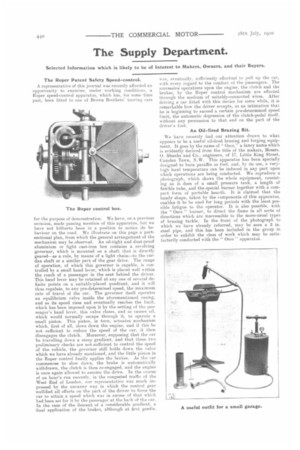The Supply Department.
Page 18

If you've noticed an error in this article please click here to report it so we can fix it.
Selected Information which is likely to be of Interest to Makers, Owners, and their Buyers.
The Roper Patent Safety Speed,-control.
A representative of this journal was recently afforded an opportunity to examine, under working conditions, a Roper speed-control apparatus, which has, for some time past, been fitted to one of Brown Brothers' tourin7 cars for the purpose of demonstration. We have, on a previous occasion, made passing mention of this apparatus, but we have not hitherto been in a position to notice its behaviour on the road. We illustrate on this page a partsectional plan, from which the general arrangement of the mechanism may be observed. An oil-tight and dust-proof aluminium or light cast-iron box contains a revolving governor, which is mounted on a shaft that is directly geared—as a rule, by means of a light chain—to the cardan shaft or a similar part of the gear drive. The range of operation, of which this governor is capable, is controlled by a small hand lever, which is placed well within the reach of a passenger in the seat behind the driver. This hand lever may be retained at any one of several definite points on a suitably-placed quadrant, and it will thus regulate, to any pre-determined speed, the maximum rate of travel of the car. The governor itself operates an equilibrium valve inside the aforementioned casing, and as its speed rises and eventually reaches the limit, which has been imposed upon it by the setting of the passenger's hand lever, this valve closes, and so causes oil, which would normally escape through it, to operate a small piston. This piston, in turn, actuates mechanism which, first of all, slows down the engine, and if this be not sufficient to reduce the speed of the car, it then disengages the clutch. Moreover, supposing that the car he travelling down a steep gradient, and that these two preliminary checks are not sufficient to control the speed of the vehicle, the governor still holds down the valve which we have already mentioned, and the little piston in the Roper control finally applies the brakes. As the car commences to slow dewn, the brake is automatically withdrawn, the clutch is then re-engaged, and the engine is once again allowed to assume the drive. In the course of an hour's run recently, in the congested traffic of the West End of London. our representative was much impressed by the uncanny way in which the control gear nullified all efforts on the part of the driver to force the ear to attain a speed which was in excess of that which had been set for it by the passenger at the bark of the ear. In the case of the descent of a considerable gradient, a 'final application of the brakes, although at first gentle, was, eventually, sufficiently effectual to pull up the car, with every regard to the comfort of the passengers. The successive operations upon the engine, the clutch and the brakes by the Roper control mechanism are effected through the medium of suitably-connected wires_ After driving a car fitted with this device for some while, it is remarkable how the driver accepts, as an intimation that he is beginning to exceed a certain pre-determined speed limit, the automatic depression of the clutch-pedal itself, without any persuasion to that end on the part of the driver's foot.
An Oil-fired Brazing Kit.
We have recently had our attention drawn to what appears to be a useful oil-fired brazing and forging equipment. It goes by the name of " Osco,' a fancy name which is evidently derived from the title of the makers, Messrs. 0. Shanks and Co., engineers, of 17, Little King Street, Camden Town, N.W. This apparatus has been specially designed to burn paraffin as fuel, and, by its use, a veryhigh local temperature can be induced in any part upon which operations are being conducted. We reproduce a photograph, which shows the whole equipment, consisting as it does of a small pressure tank, a length of flexible tube, and the special burner together with a compact form of portable hearth. It is claimed that the handy shape, taken by the components of this apparatus, enables it to be used for long periods with the least possible fatigue to the operator. It is also possible, with the " Osco " burner, to direct the flame in all sorts of directions which are inaccessible to the more-usual types of brazing tackle. In the front of the photograph to which we have already referred, may be seen a 3 in. steel pipe, and this has been included in the group in order to exhibit the class of work which may be satisfactorily conducted with the " Osco " apparatus.




















